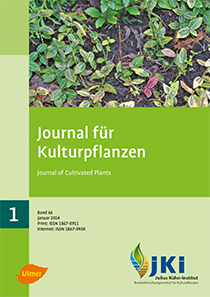Influence of temperature and exposure time on the mortality of Tribolium castaneum eggs at fumigation with sulfuryl fluoride with regard to the progressive egg development
Keywords:
Tribolium castaneum, sulfuryl fluoride, egg stage, larval developmentAbstract
Sulfuryl fluoride has become an important replacement of methyl bromide and is nearly without alternatives in some situations in stored product protection. At the same time the information on egg mortality of Tribolium castaneum (Herbst, 1797) to sulfuryl fluoride from literature is not sufficient. Data on mortality of Tribolium castaneum eggs fumigated with sulfuryl fluoride are given in the presented publication. Based on mortality tests, lethal Ct-products (Concentration × time products) are calculated for different temperatures and exposure periods with the help of Probit analysis. In 48 h exposure tests the lethal Doses LCt95 for 0–5 day old eggs were as follows: 4000 g*h/m3 (15°C), 4820 g*h/m3 (20°C), 2788 g*h/m3 (25°C) and 1047 g*h/m3 (30°C). Values for LCt99 were calculated to: 5795 g*h/m3 (15°C), 8948 g*h/m3 (20°C), 5327 g*h/m3 (25°C) and 1737 g*h/m3 (30°C). At 24 h exposure lethal doses LCt95 were: 3480 g*h/m3 (15°C), 2378 g*h/m3 (20°C), 1450 g*h/m3 (25°C) and 969 g*h/m3 (30°C). A 72 h exposure resulted in LCt95: 5045 g*h/m3 (15°C), 4675 g*h/m3 (20°C), 1889 g*h/m3 (25°C) and 557 g*h/m3 (30°C). More results for 24 h und 72 h exposure are described.
The mortality in dependence of the egg age 0–1 days to 4–5 days was tested with an 24 h, 48 h and 72 h exposure with 40 g/m3 sulfuryl fluoride at 20°C. In particular the 24 h test revealed the young eggs as the most tolerant. The hatch of eggs and their natural mortality were observed in dependence of temperature. In this context the calculated and observed lethal doses are discussed. It cannot be excluded, that some of the 0–5 day old eggs develop during the exposure to sulfuryl fluoride into larvae. A contribution of the more susceptible larval stage to the egg mortality is very likely.
DOI: 10.5073/JfK.2014.01.02, https://doi.org/10.5073/JfK.2014.01.02








